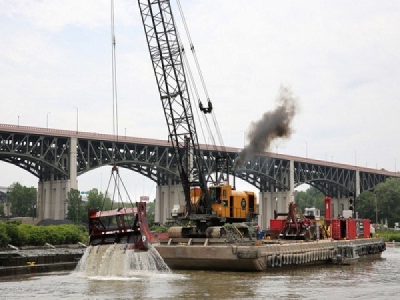
Posted on October 9, 2018
The county’s long-sought dredging of the Eastpoint Channel could begin as early as next summer, if a series of steps fall into place regarding RESTORE Act monies and an Army Corps of Engineering redesign of the project.
In a lengthy report to county commissioners Tuesday morning, former County Planner Alan Pierce, now the county’s liaison for securing monies stemming from the 2010 BP oil spill, sounded an optimistic note regarding the dredging, a project the county sought, unsuccessfully, to secure funds for over at least the past two decades.
He said a meeting last week with Waylon Register, site manager for the Corps out of the Panama City office, reaffirmed the Corps has received $2 million in the upcoming year to dredge the channel, for which it holds the permit to dredge and dispose of materials on the water side of the breakwater.
Costs for the project, however, are expected to be higher, because of problems associated with the current design to have the disposal area surrounded by geo tubes to hold in the spoil, and then planted as if it is a marsh environment.
“The problem has come out that the geo tubes the Corps have used in other projects have ‘underperformed,’ to use Mr. Register’s term, and have created maintenance liability problems for the Corps and the local sponsor, being the county,” Pierce told commissioners. “The berms fail, the mud goes back in the water and you haven’t accomplished anything, so the Corps is re-evaluating the construction of the berms.”
Pierce said the Corps has tasked a nationwide consulting firm, Anchor QEA, to help design a better solution. “If the proposed construction costs of the re-designed disposal area are higher, the Corps would then have to reduce the extent of the dredging because they have no additional funds,” Pierce said, noting he told Register the county would want the full extent of the channel dredged.
“I told him that it might be possible for the county to provide some additional funds to keep the project on track and at the size it was originally designed,” he said.
Pierce said he was told the Corps hopes to complete its analysis of the new disposal design by year’s end, “and if everything is favorable (the project) will start in summer of 2019.”
Pierce said one way for the county to secure additional funds for the dredging would be to move the project higher on its list of priorities for securing funds from the RESTORE Council, an aggregation of the five states affected by the BP oil spill, and six federal agencies responsible for the federal recovery of the Gulf of Mexico.
Pierce outlined to commissioners how the RESTORE Council has final approval over the State Expenditure Plan, and is responsible for authorizing and releasing funds for projects in the SEP.
“While the RESTORE Council has control over some $300 million in funds, the individual counties will only get their share of the principal, which in the case of all counties in Florida is some $11 million,” he said. “All interest generated by unspent funds stays with the US Treasury; no additional funds are going to the counties.”
Pierce said that while the county’s current priority is to use these RESTORE funds to build a new emergency operations center, it would make better sense to make channel dredging the first to be funded in the SEP, when the first round of funds become available by summer 2019.
“I think that’s a bigger public interest right now,” he said. “I hope in December we hear a more complete report from the Corps.”
Pierce said that if the Corps tells the county that it is ready to start dredging the Eastpoint Channel in 2019, the county could delay the construction of the emergency operations center and use that $1 million to keep the Eastpoint Channel moving forward.
“We don’t have a bunch of money to be putting out for stuff,” said Chairman Smokey Parrish.
Pierce said the RESTORE monies, once earmarked for the project, could quickly reimburse the county.
“It will be April or May before we see anything,” said Commissioner Cheryl Sanders, a longstanding representative of the county with the Gulf Consortium, the body of Florida’s 23 Gulf Coast counties, from Escambia County to Monroe County, tasked with overseeing expenditures of RESTORE Act monies.
“The larger counties are ready to get out there. We’re at a critical time for this in the county,” said Sanders, who is retiring from her seat on the county commission, ahead of the upcoming consortium meeting at the end of November in Hillsborough County.
Sanders pledged her support to brief the commissioners on the consortium’s work. “We can’t miss none of those meetings,” she said.
Source: The Times





